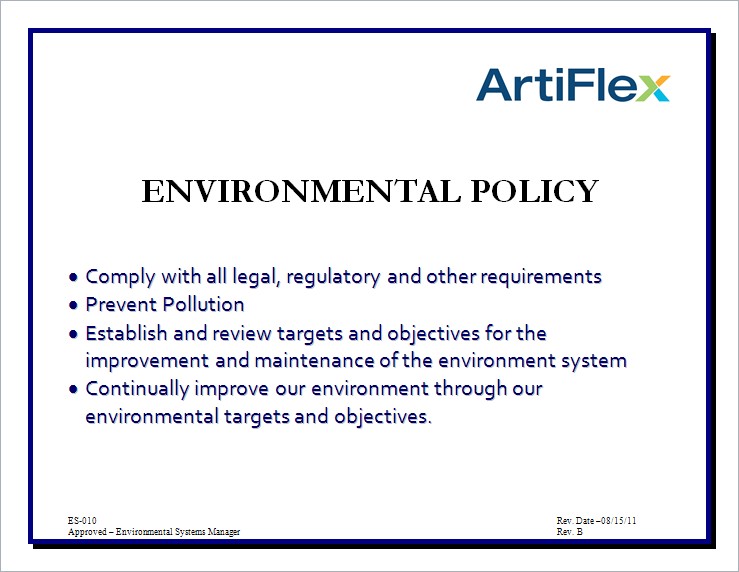Information
-
Site
-
Conducted on
A. Plant Tour
-
A.1 Tour the facility inside and out. Use the 'Documenter' tool to take photos of 'Good' and 'Not Good' conditions observed during the tour.
-
B.1 Documenter
Condition
-
-A Photograph
-
-B Rate the condition.
-
Comments
B. Environmental Policy Statement (4.2)
-
Switch to see Environmental Policy.
-
This is the current environmental policy.
-
B.1. Is the Environmental Policy posted in various areas of the facility?
-
Our EMS Manual establishes the Management Team as responsible for these requirements relative to the Environmental Policy:
1. To ensure it is appropriate to the nature, scale and environmental impacts of its activities, products and services.
2. It includes a commitment to continual improvement and prevention of pollution.
3. It includes a commitment to comply with relevant environmental legislation and regulations, and with other requirements to which the company subscribes.
4. That it provides a framework for setting and reviewing environmental objectives and targets.
5. It is documented, implemented and maintained and communicated to all employees.
6. Is available to the public -
B.3 Given what we do, there are few aspects and minimal impact to the environment. The exception is the e-Coat line in Wooster. Our policy is appropriate to the size of the organization and the nature of our work. Requirements 2, 3, and 4 are contained within the policy itself, and our website publishes the Environmental Policy. <br><br>Are there records to show that employees have had the policy communicated to them?
C. Environmental Aspects (4.3.1)
-
C.1 ESP 03.01 establishes the EFMEA (Environmental Failure Mode and Effects Analysis) as the means of identifying significant environmental impacts. Has the EFMEA been updated for the site within the last 12 months?
-
C.2 What is the date of last EFMEA revision?
-
C.3 Discuss with Management observed environmental impacts that do not appear in the EFMEA. Do the reasons for not including them make sense?
-
C.4 Review the Good / Not Good photos from the Plant Tour. Is Management aware of the conditions? Are there already plans to address the Not Good?
D. Legal and Other Requirements (4.3.2)
-
D.1 ES.014 lists Environmental Legal Requirements. Review all requirements, permits, licenses, etc., for the site. Are all requirements met?
-
D.2 Has ES.014 been reviewed and / or revised in the last 12 months?
-
D.3 Do containers of chemicals have HMIS or GHS labels applied to notify employees of associated hazards?
E. Environmental Objective and Target (4.3.3)
-
E.1 Discuss with Management how the objectives and targets were established in the last revision to the EFMEA. Were these taken into account:<br><br>1. Legal and other requirements?<br>2. Significant environmental aspects?<br>3. Commitment to prevention of pollution?<br>4. Views of interested parties?<br>
-
E.2 Are there appropriate objectives and targets for every level of the organization?
-
E.3 Are the objectives and targets consistent with the Environmental Policy statement?
-
E.4 Are the objectives and targets documented?
F. Environmental Management Programs (4.3.4)
-
F.1 Has the organization established programs for meeting its environmental objectives and targets?
-
F.2 Has responsibility been assigned at all appropriate levels of the organization?
-
F.3 Has a schedule(s) been established to meet all of the targets?
-
F.4 Have the appropriate "mechanisms" been supplied?
-
F.5 Is the environmental management program followed within the organization?
-
F.6 Utilizing the principle of continual improvement does the organization modify as necessary its environmental management programs?
G. Structure and Responsibility (4.4.1)
-
G.1 Has the organization defined the roles, responsibilities, and authorities of its employees with respect to the environmental management system?
-
G.2 Have these roles, responsibilities, and authorities been documented and communicated?
-
G.3 Have the following resources been provided to implement and maintain the system:<br>a. human resources (manpower),<br>b. special skills,<br>c. technology, and<br>d. financial resources?
-
G.4 Has a management representative been appointed?
-
G.5 Does the management representative have the following defined role:<br>a. establishing ISO 14001 requirements,<br>b. determining whether ISO 14001 requirements have been implemented,<br>c. determining whether the ISO 14001 conformance is maintained,<br>d. reporting to top management on conformance and continual improvement?<br>
H. Training, Awareness and Competence (4.4.2)
-
H.1 Has the organization defined its training needs?
-
H.2 Has the entire organization been provided baseline training related to the following?<br>Importance of the EMS / Roles within organization related to the EMS / Consequences of deviating from the EMS<br>
-
H.3 Does the organization require and provide training for those positions that could have a significant impact on the environment based upon education and experience?
-
H.4 Does the organization require and provide training with respect to emergency preparedness and response?
-
H.5 Has the organization developed competency standards?
I. Communication (4.4.3)
-
I.1 Does the organization have an internal communication process for the environmental management system?
-
I.2 Does the organization have a process in place for receiving and responding to relevant external communications?
-
I.3 Has the organization decided whether it will communicate to external parties information with respect to its significant environmental aspects?
-
I.4 If the organization has decided not to communicate information to external parties with respect to its significant environmental aspects, has it established a record of that decision?
J. Environmental Management System Documentation (4.4.4)
-
J.1 Has the organization documented information that describes the foundation elements of the environmental management system and how they interact?
-
J.2 Does the documented information reference all the necessary supporting information?
K. Document Control (4.4.5)
-
K.1 Has the organization established procedures for controlling all of the documents required by the standard?
-
K.2 Does the procedure insure that all the documents can be located at the necessary workstations?
-
K.3 Are the following items addressed on each controlled document:<br>a. revision number<br>b. authorized signature<br>c. date of issuance<br>d. readily identified.<br>
-
K.4 Does the organization maintain a current master list of authorized documents?
-
K.5 Does the organization maintain a process of removing out of date documents?
L. Operational Control (4.4.6)
-
L.1 Has the organization identified its operations that are associated with its Significant Environmental Aspects?
-
L.2 Has the organization developed procedures and operational criteria, including maintenance, that address those operations?
-
L.3 Does the organization communicate relevant portions of its environmental management system to suppliers and contractors who have the potential to interact with its Significant Environmental Aspects?
M. Emergency Preparedness and Response (4.4.7)
-
M.1 Has the organization evaluated its operations with respect to potential emergency situations and accidents?
-
M.2 Has the organization developed procedures to respond to such potential emergency situations and accidents?
-
M.3 Does the organization periodically test the procedures?
N. Monitoring and Measurement (4.5.1)
-
N.1 Does the organization have documented procedures to monitor and measure on a set frequency the characteristics of its operation that are related to the significant environmental aspects?
-
N.2 Does the organization have proper calibration procedures to insure that measurements are accurate and reproducible?
-
N.3 Does the organization record and maintain the above information?
O. Nonconformance and Corrective and Preventive Action (4.5.2)
-
O.1 Does the organization have an established procedure for defining responsibility and authority for:<br>Investigating nonconformance?<br>Initiating mitigation activities?<br>Performing corrective action?<br>Completing preventative action?
-
O.2 Does the organization modify existing procedure when appropriate to prevent nonconcurrence?
-
O.3 Does the organization have a documented procedure with a set frequency to evaluate compliance with applicable environmental laws and regulations?
P. Records (4.5.3)
-
P.1 Has the organization established record retention procedures?
-
P.2 Do these procedures address record identification, maintenance and retention?
-
P.3 Does the organization include all the records necessary to support the EMS within the records retention procedures:<br>legal and other requirements?<br>permits?<br>environmental aspects and impacts?<br>environmental training?<br>inspection and calibration records?<br>monitoring data?<br>nonconformance information?<br>environmental audits?<br>management reviews?<br>emergency preparedness?
Q. Environmental Management System Audits (4.5.4)
-
Q.1 Has the organization established a program and procedure for an EMS audit?
-
Q.2 Are the program and procedure designed to:<br>Determine conformance to the EMS?<br>Determine conformance with ISO 14001?<br>Provide reports to top management?
-
Q.3 Does program recognize the need for increased audit frequency for areas of the EMS with previous nonconformance?
-
Q.4 Does the program require competency of the auditors?
R. Management Review (4.6)
-
R.1 Does the organization’s top management routinely review the EMS for effectiveness?
-
R.2 Is there a set schedule for the reviews?
-
R.3 Are the management reviews documented?
-
R.4 Does the review information include:<br>Compliance information based upon applicable environmental laws, regulations and permits?<br>Internal audit reports?<br>Reports on the achievement of Environmental Targets?<br>Information related to changing environmental aspects and impacts?<br>Summaries of internal and external communications related to the EMS?
-
R.5 Does management include in the review the concept of continual improvement?
-
R.6 Does the management review focus on potential modifications to the Environmental Policy statement and the Environmental Objectives?
S. Auditor Sign-off
-
Auditor is to sign, signifying completion of the audit.










